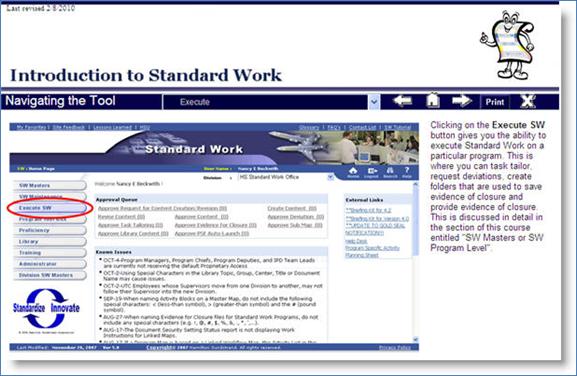| October 2010 Index | Home Page |
Editor’s Note: This study provides readers with a practical example of incorporating adult learning theories into asynchronous, web-based courses. The article was written to help course developers understand that to be effective, asynchronous web-based courses (especially those that are not facilitated) must follow basic instructional design and adult learning principles. Educators in the academic and business worlds should benefit from these ideas and guidelines for incorporating basic and valid instructional design techniques in media delivered adult learning.
Five Simple Ways of Incorporating Principles, Theories and Models of Adult Learning into an Asynchronous, Unfacilitated, Web-based Course
Mary Bollash
USA
Abstract
Asynchronous, un-facilitated web-based courses, in which the learner interacts with a computer in order to learn some very specific content, can and should include best practices of adult learning theories and models. The purpose of this qualitative study was to utilize the case study format to provide an example of an un-facilitated, asynchronous web-based course, which includes several best practices from adult learning literature. The case study involves an online course which is distributed to learners who are employees of a Fortune 500 company. These employees are located in divisions all over the world. The course is mandatory for employees who need to access a specific enterprise-wide web application. The intent of the researcher is to provide a possible set of guidelines and best practices for individuals who are tasked with creating such an interactive, web-based course.
Keywords: Asynchronous, web-based, andragogy, self-directed learning, narrative, relevance, experience, immediate application of knowledge.
Introduction
How can a large, global company or organization create an asynchronous, stand-alone, web-based course that presents the content in an effective manner, while ensuring the learner’s time is used most efficiently? The answer is by ensuring adult learning principles are incorporated into the design and development of the course. The case study revolves around a one hour, interactive, asynchronous, un-facilitated web-based training module. For this course, there is no instructor. The course is available in languages other than English, but for the purposes of this paper, all examples will be shown from the English version. All of the content is presented to the learner via an interactive web-based training module which is available to learners 24 hours a day, 7 days a week, no matter where they are physically located. The training module was created to introduce the students to an enterprise-wide tool that supports the quality system. For purposes of this article, the tool will be referred to as the SW web tool. This course was intentionally created from original material and not from pre-existing course content. The design and development of this course was done with the intention of developing an effective solution for adult learners. The tool is proprietary to the organization for which it was created, but the training course will be reviewed here so the reader can see how the adult learning theories and principals have been integrated throughout the course. When the course was designed and developed, it was released to approximately 4,000 learners. Feedback from those learners is also included in the results section of this article.
Review of Literature
According to Bruner (2010), “learning is an active process in which learners construct new ideas or concepts based on their current/past knowledge”. Merriam, Cafarella and Baumgartner (2007) summarize the concepts of andragogy, presented by Knowles as : a) adult learners are self-directed learners, b) adults have experience which is a resource for learning, c) adults’ readiness to learn is related to his or her social role, d) adults like to solve problems when they learn so they want information that they can apply to real life challenges, e) adults are internally motivated to learn, and f) adults need to/like to know why they need to learn something (learning should be relevant to them). This model has proven to be accurate in many ways and elements of it are clearly demonstrated in the case study to be reviewed. Merriam et al. (2007), also state that stories are often used to help learners relate to information being taught. The literature clearly shows that narrative learning (through case studies and stories), experiential learning (through hands on application of concepts), reflective learning (through journaling and other techniques), and self directed learning (where the learner is responsible for his or her learning) are all very relevant to technology based learning.
Methodology and Data Collection
The methodology used in this study was three fold. The first step was to identify a course that could be used as the basis for this case. The course selected had to be designed with adult learning in mind. In other words, the course could not have been designed by a content expert that was not an instructional designer. The researcher evaluated five different courses to identify one that utilized the most adult learning principles and practices. The second step was to evaluate various adult learning models and theories for their applicability to online learning. The researcher had to consider various adult learning principles, theories and models and select those with the greatest transferability to asynchronous, un-facilitated, web-based training. The third step was to compare the principles of adult learning to what was in the course. Nothing in the course was allowed to be modified for the purposes of this article, except screen shots that identified the company that owns the tool that the training was designed to support. Learner feedback from the course was also collected in order to determine the effectiveness of the course.
Data Analysis
The best practices described in the literature were identified and examples of the implementation within the case study course were provided. Additionally, graphical elements which depict the best practice were also included in this document to make it clear to the reader how principles of adult learning are incorporated in this very brief course, (Merriam et alii, 2007).
Best Practice from Literature Review: Adult learners want to direct their own learning.
How was it implemented in this course? The navigation lets the learner progress sequentially or skip to sections of the course in which he or she is interested.
See Figure 1.
Also, on various screens, the learner has a choice regarding items that he or she would like to learn more about. Branching is provided for role-based tangential information so it is truly the learner’s choice if he or she wants to explore a particular concept further.
Best Practice from Literature Review: Narratives can be used to tell stories. Stories help learners engage with the material and show how the information might be relevant to other learners as well.

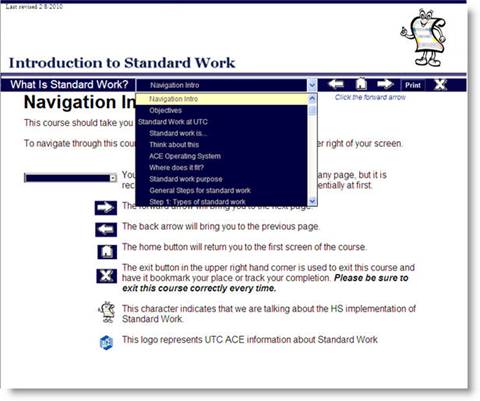
Figures 1a and 1b
How was it implemented in this course?
The entire course is constructed around a scenario involving two people. One of the people is just being introduced to the enterprise-wide tool. She has no experience with it at all, which is the same position that the learners who are taking the course are in as they begin this course. The other has some experience which he is willing to share. Throughout the course, the learner is engaged as he or she follows the novice learning about the tool. The novice asks questions which have been asked by real learners. The novice probes for more information and the pieces of information build on each other. See Figure 2.

Figure 2
Best Practice from Literature Review: Previous experience is a resource for learning.
How was it implemented in this course? The course connects the enterprise-wide quality system that is well known to most employees with the information about the new tool and how it relates to the quality system, the employees are used to. For new employees, the course also provides background on what the enterprise-wide quality system is and how it works.
See Figure 3.
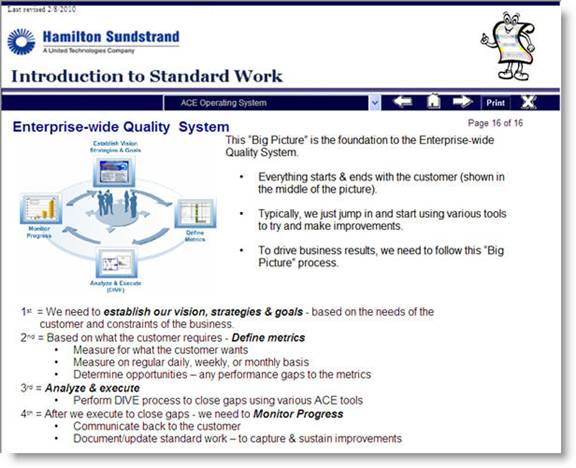
Figure 3
Best Practice from Literature Review: An adult’s readiness to learn is related to his or her social role (Merriam et al. 2007).
How was it implemented in this course? The course has been implemented as a prerequisite to gaining access to the enterprise-wide application that many employees need to do their jobs correctly. This seems as if it may be counter-intuitive to one of the principals of adult learning, which is the internal motivation described by Merriam et al. (2007) while describing Knowles model of andragogy, and to an extent it is. Since this initiative was driven by senior management to meet a business need, internal motivation is not really a factor in this situation.
The course also speaks to the specific roles users can have in the tool and information is presented specifically to that role. See Figure 4.
Best Practice from Literature Review: Adults learn best when attempting to solve problems and apply training to a real life situation. (Merriam et al. 2007).
How was it implemented in this course? The course does this in several ways. It shares success stories of how others have implemented the tool in order to make a positive business difference. (Figure 5). It also gives the learners step by step instructions regarding the actual physical use of the tool (i.e. it shows the learner which buttons to click once he or she is in the tool. (Figure 6).
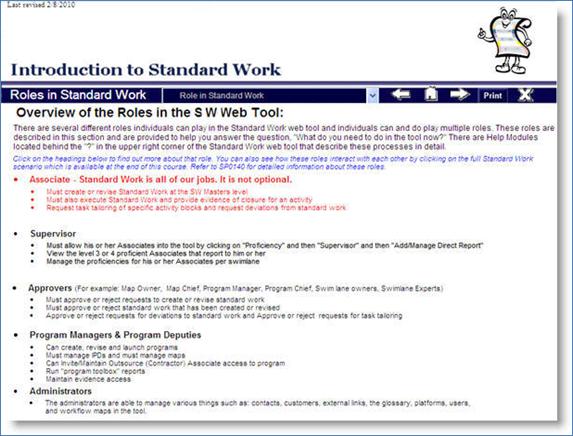
Figure 4.
Figure 5
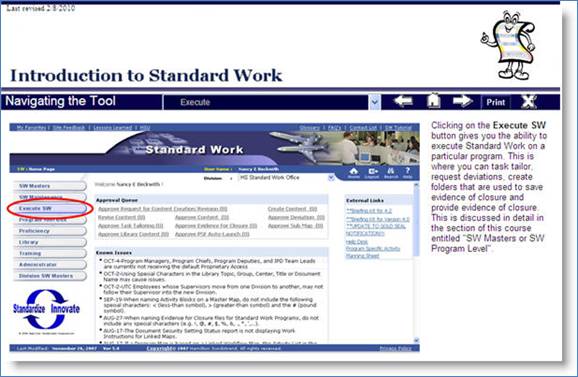
Figure 6
Findings
Learner Feedback
Learners provided feedback regarding the effectiveness of this course which was collected over a period of about a year. Learner feedback consistently showed that learners felt that when they had completed the course, they could successfully meet the learning objectives. The learning objectives for this course were:
“Upon completion of this course, learners will be able to:
§ Describe the steps used to implement Standard Work
§ Demonstrate an awareness of what Standard Work is, both from the enterprise and divisional perspectives
§ Demonstrate an understanding of the Standard Work web tool
§ Identify the benefits of Standard Work
§ Recognize transition is a Cultural Change”
The findings of this case study indicate that the principles of adult learning can be incorporated in to asynchronous, un-facilitated web-based courses, if they are considered in the design and development of the web-based course from the beginning. The learners provided qualitative feedback as well, that was a testimonial to the course design. They commented that they felt engaged in the learning and they felt it was relevant. They liked the independence of not being tied to a specific time or location. Additionally, learners felt that taking this training course was an effective use of their time because it only took most learners one hour to complete the module. Once they completed the course, they were able to gain access to the SW Web tool, and apply the knowledge they had gained in the course.
Implications and Conclusions
This particular case study focused on just a few of the principles and theories of adult learning although there are many other models which could have been selected for other types of asynchronous online learning. For example, if a facilitator was participating in the course, models which focused on building a sense of community within the course could have been more prominent (Merriam et al. 2007). If the objective of the course was to change or impact the values of the learner, the transformational learning theory could have played a significant role.
The main conclusion for this study is that the use of instructional design principles, models and theories is appropriate, and based on learner feedback, should be encouraged to make asynchronous, un-facilitated web-based courses effective vehicles for adult learning. It should be noted that courses do not need to be extremely complex or require a large budget to be effective learning tools. Learners completed the course in an hour. This course was created in-house, and it did not utilize significant multimedia elements. The course was also not very complex from a software perspective. In future research, this topic could be developed to demonstrate how other principles and theories of adult learning could be incorporated into asynchronous, un-facilitated, web-based courses.
References:
Bruner, J. Retrieved February 2, 2010 from http://tip.psychology.org/bruner.html
Merriam, S.B, Caffarella, R.S. and Baumgartner, L.M. (2007). Learning in adulthood: a comprehensive guide. San Francisco, CA: Jossey-Bass.
About the Author
Mary Bollash is a training and development manager for a division of United Technologies Corporation who has been working in this field since 1991. For the last 15 years, she has specialized in Instructional Design for online learning. Mary is a scholar-practitioner, currently finishing her PhD in Education, from Capella University. Mary also holds Masters Degrees in Instructional Design for Online Learning and in Organizational Management. Her experience and education focus on adult learning, corporate training and designing effective online learning. She also acts as consultant to professors at Manchester Community College, helping them transition their content from on-ground to on-line learning.
email: Mary.Bollash@hs.utc.com
